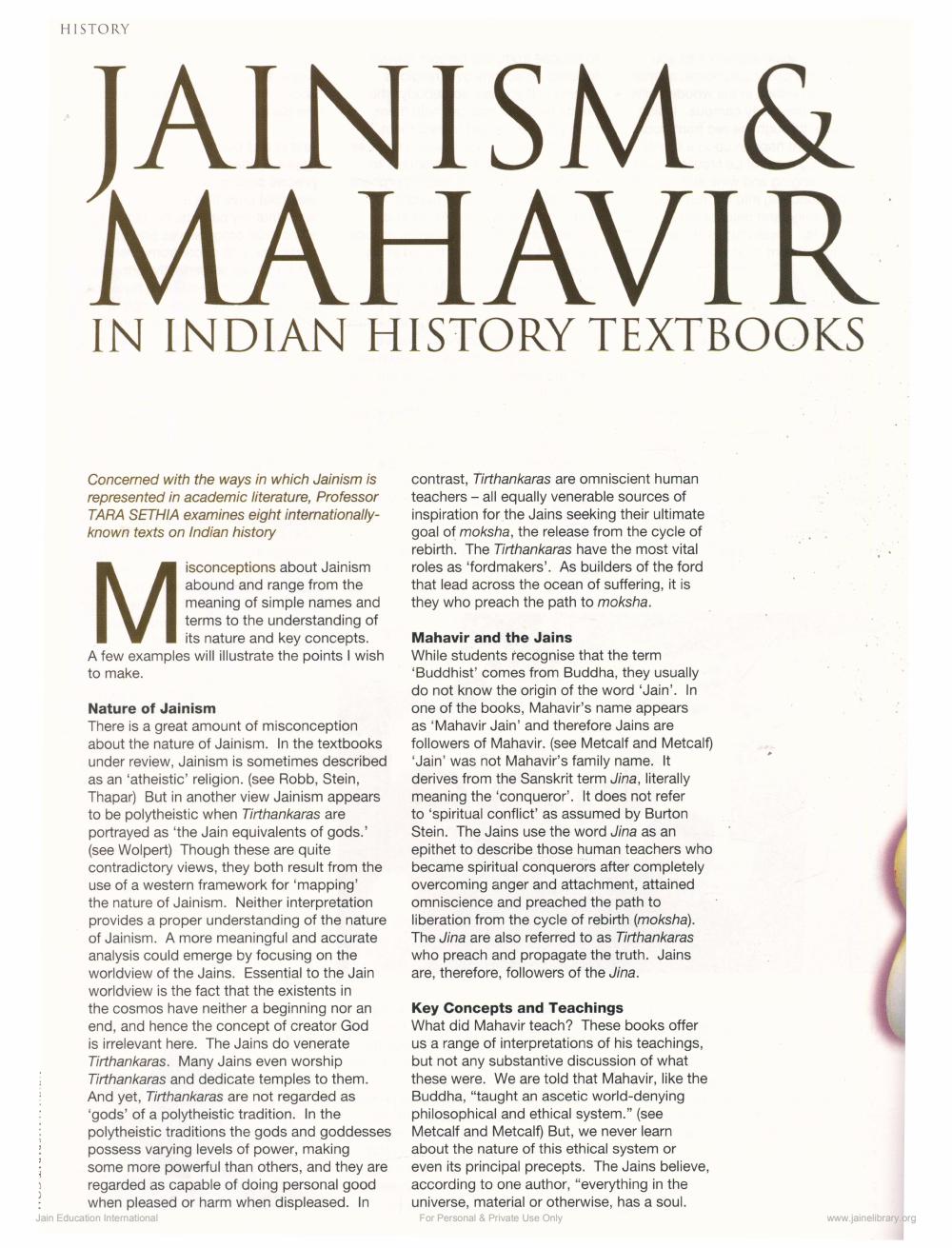________________
HISTORY
JAINISM & MAHAVIR
IN INDIAN HISTORY TEXTBOOKS
Concerned with the ways in which Jainism is represented in academic literature, Professor TARA SETHIA examines eight internationallyknown texts on Indian history
contrast, Tirthankaras are omniscient human teachers - all equally venerable sources of inspiration for the Jains seeking their ultimate goal of moksha, the release from the cycle of rebirth. The Tirthankaras have the most vital roles as 'fordmakers'. As builders of the ford that lead across the ocean of suffering, it is they who preach the path to moksha.
isconceptions about Jainism abound and range from the meaning of simple names and terms to the understanding of
its nature and key concepts. A few examples will illustrate the points I wish to make.
Nature of Jainism There is a great amount of misconception about the nature of Jainism. In the textbooks under review, Jainism is sometimes described as an 'atheistic' religion. (see Robb, Stein, Thapar) But in another view Jainism appears to be polytheistic when Tirthankaras are portrayed as 'the Jain equivalents of gods.' (see Wolpert) Though these are quite contradictory views, they both result from the use of a western framework for 'mapping the nature of Jainism. Neither interpretation provides a proper understanding of the nature of Jainism. A more meaningful and accurate analysis could emerge by focusing on the worldview of the Jains. Essential to the Jain worldview is the fact that the existents in the cosmos have neither a beginning nor an end, and hence the concept of creator God is irrelevant here. The Jains do venerate Tirthankaras. Many Jains even worship Tirthankaras and dedicate temples to them. And yet, Tirthankaras are not regarded as 'gods' of a polytheistic tradition. In the polytheistic traditions the gods and goddesses possess varying levels of power, making some more powerful than others, and they are regarded as capable of doing personal good
when pleased or harm when displeased. In Jain Education International
Mahavir and the Jains While students recognise that the term 'Buddhist' comes from Buddha, they usually do not know the origin of the word 'Jain'. In one of the books, Mahavir's name appears as 'Mahavir Jain' and therefore Jains are followers of Mahavir. (see Metcalf and Metcalf)
Jain' was not Mahavir's family name. It derives from the Sanskrit term Jina, literally meaning the 'conqueror'. It does not refer to 'spiritual conflict' as assumed by Burton Stein. The Jains use the word Jina as an epithet to describe those human teachers who became spiritual conquerors after completely overcoming anger and attachment, attained omniscience and preached the path to liberation from the cycle of rebirth (moksha). The Jina are also referred to as Tirthankaras who preach and propagate the truth. Jains are, therefore, followers of the Jina.
Key Concepts and Teachings What did Mahavir teach? These books offer us a range of interpretations of his teachings, but not any substantive discussion of what these were. We are told that Mahavir, like the Buddha, "taught an ascetic world-denying philosophical and ethical system." (see Metcalf and Metcalf) But, we never learn about the nature of this ethical system or even its principal precepts. The Jains believe, according to one author, "everything in the universe, material or otherwise, has a soul. For Personal & Private Use Only
www.jainelibrary.org




